Thursday October 11th has been designated as National Depression Screening Day, an annual event held during Mental Illness Awareness Week. This event was started 28 years ago as an effort to provide people with mental health education materials and resources for support services. National Depression Screening Day was also created with the hope of removing the stigma from mental illness.
This year the focus of the observation is to have people reach out to their friends, family, co-workers and neighbors who might benefit from information on this condition and to avail themselves to the many opportunities to receive a free screening, either in person or online. It is estimated that worldwide there are 350 million people that suffer from depression.
The World Health Organization states that early recognition and treatment of the disease offers the best opportunity for successful outcomes. If depression is left untreated it can lead to suicide.
Depression screenings help to distinguish between short term feelings of sadness and stress due to transient life episodes, and more severe symptoms that can go on for months and years. The tests usually last between two to five minutes and the scores will indicate whether a further evaluation by a mental health professional is needed. It is important for people to know that help is available.
To schedule an appointment with the Mental Health Department of Flushing Hospital Medical Center, please call 718-670-5562.
All content of this newsletter is intended for general information purposes only and is not intended or implied to be a substitute for professional medical advice, diagnosis or treatment. Please consult a medical professional before adopting any of the suggestions on this page. You must never disregard professional medical advice or delay seeking medical treatment based upon any content of this newsletter. PROMPTLY CONSULT YOUR PHYSICIAN OR CALL 911 IF YOU BELIEVE YOU HAVE A MEDICAL EMERGENCY.

